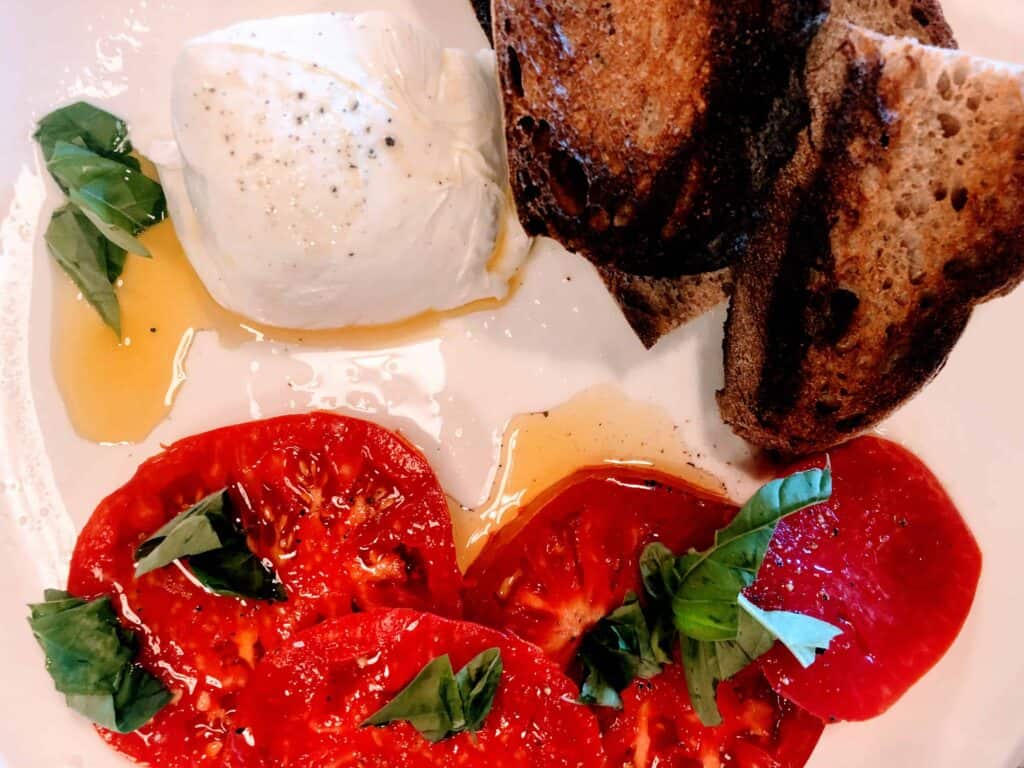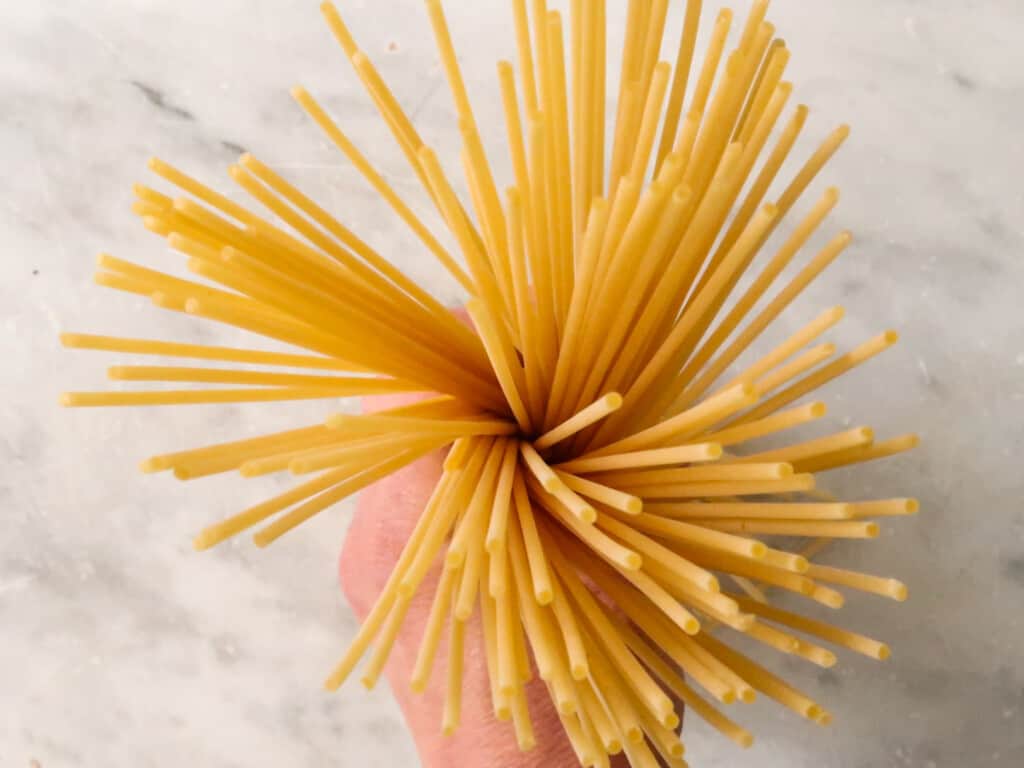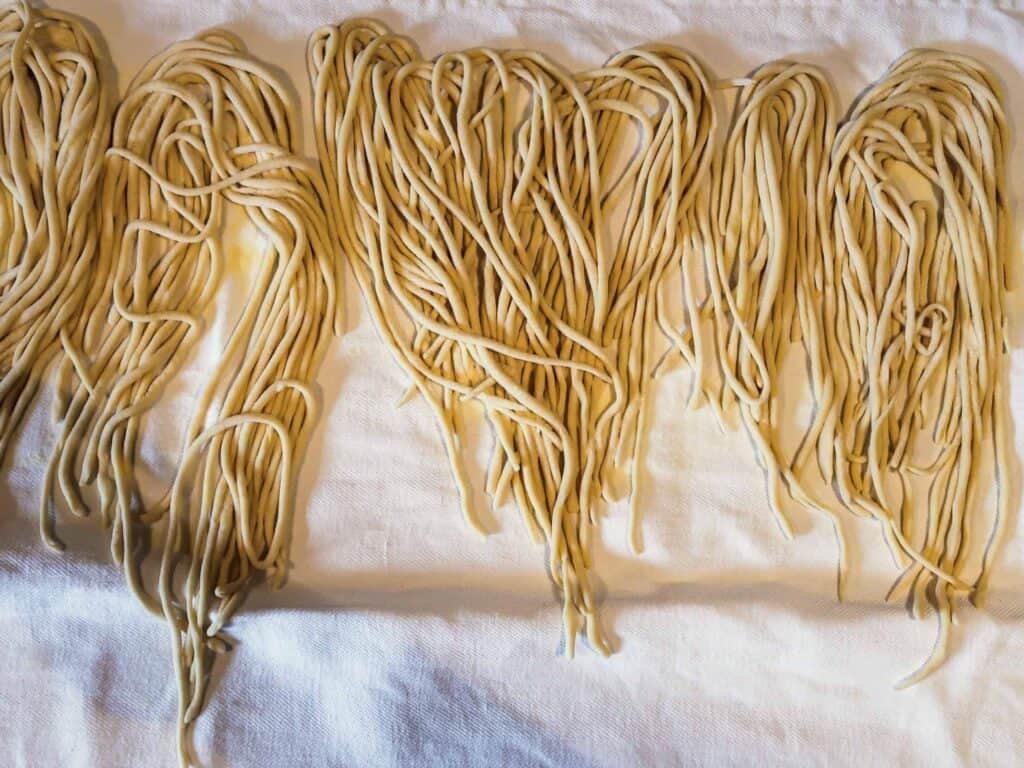Last updated on May 6th, 2024
If you’ve been to Italy, you probably noticed that the bread offered on the table differs from region to region, (and sometimes from village to village).
This is because the Italian tradition of bread making is older than pasta making and just like pasta, each region treasures its own bread specialty, developed over centuries by their ancestors.
Although the Italian world of bread isn’t quite as vast as that of pasta, it’s worth demystifying the various types of Italian bread and where exactly to eat them.
In this article I will go over:
- How to say and pronounce bread in Italian
- The different flours used in Italian bread baking
- When we eat bread in Italy
- The different certifications of authenticity for Italian breads
- The most popular Italian breads and where to find them
- Other regional varieties of bread in Italy
- Gluten-free bread in Italy
Jump to Section
Map of Where to Eat Italian Breads
How to Pronounce Bread in Italian
Bread in Italian is pane pronounced pah-neh.
Listen to the pronunciation of pane:
Types of Flours Used to Make Bread in Italy

There is no hard and fast rule for what kind of flour is used to make Italian bread because there are so many regional specialties, each of which uses different flours based on what is grown in that region or based on age-old traditions.
Many Italian breads are made with durum wheat, as it grows very well in southern Italy.
Here is a quick lineup of the most popular flours used:
- Durum wheat
- All-purpose
- Whole wheat
- Rye
Learn More: Don’t miss our full guide to Guide to Italian Flour – Straight from Italy for details about specific Italian flours and for what they are used.
When We Eat Bread in Italy
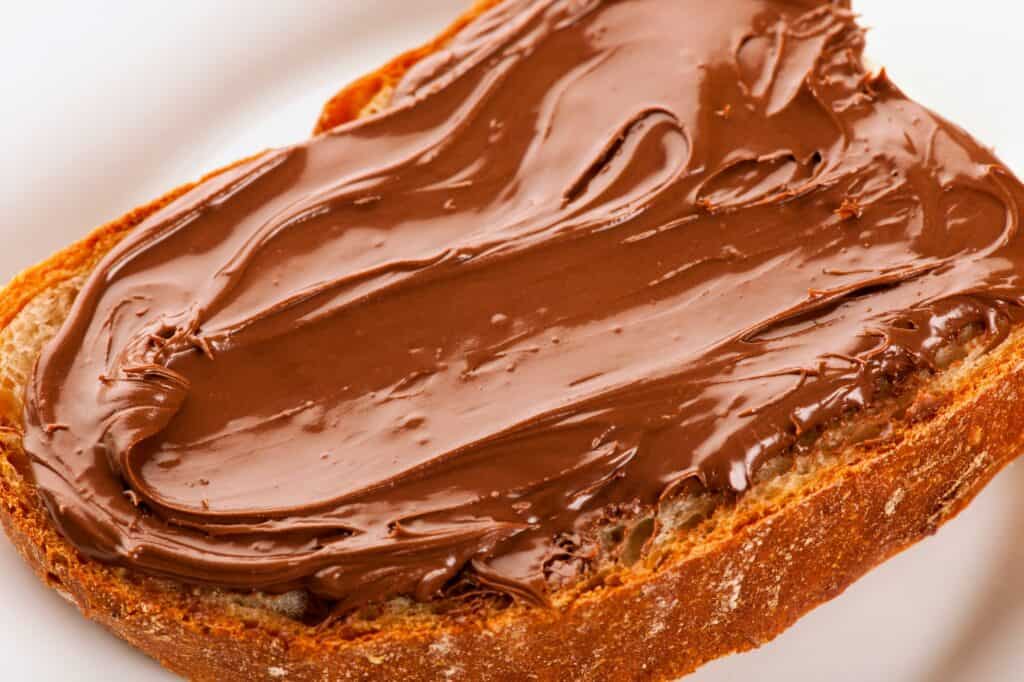
Although perhaps not quite as important as pasta, bread anyhow plays a vital role on the Italian table and in daily life.
Bread is eaten for:
- Prima colazione: for breakfast either fresh or in cassetta (pre-packaged sliced sandwich bread) with jam or nutella.
- Colazione: as a morning snack for kids or blue collar workers with a slice of prosciutto cotto or crudo, cheese, or in the form of focaccia.
- Pranzo: alongside lunch or made into a sandwich
- Merenda: for an afternoon snack either as a small sandwich or in the form of focaccia.
- Aperitivo: cut into small squares served with cocktails before dinner
- Cena: alongside dinner, most typically with a second course meal or just a crust to mop up pasta sauce leftover on the plate.
DOP and PGI Italian Breads
You will notice many products in Italy are marked by these two certificates (DOP and PGI), but what do they mean? They are a way of ensuring the authenticity of a product. In other words, that the food item is not being copied or changed from the original way of making it.
DOP stands for Denominazione di Origine Protetta in Italian, meaning “Protected Designation of Origin” in English. It’s the stamp of authenticity given to products that are produced in a certain manner from a specific geographical location.
PGI, standing for Indicazione Geografica Protetta, meaning “Protected Geographical Indication”, is another stamp of approval referring to the geographical origin of the food.
The DOP certificate is harder to obtain because the ingredients, making of, and packaging of the product must come from a certain designated area and must follow specific methods of production. IGP, on the other hand, is given to products in which the main ingredient or phase of the production comes from the specific geographic area.
Today there are nine DOP/IGP designated breads in Italy:
- Pane di Matera IGP (Basilicata)
- Coppia Ferrarese PGI (Ferrara, Tuscany)
- Focaccia di Recco col formaggio PGI (Liguria)
- Pagnotta del dittaino DOP (Sicily)
- Pane Casareccio di Genzano IGP (Lazio)
- Pane di Altamura DOP (Puglia)
- Pane Toscano DOP (Tuscany)
- Piadina romagnola IGP (Emilia-Romagna)
- Südtiroler Schüttelbrot IGP (Trentino Alto-Adige)
Main Types of Bread in Italy
There are so many types of bread in Italy as recipes change from village to village so it would be impossible to list them all. Instead, I am providing a comprehensive list of the most famous and popular breads that you will cross paths with on your Italian travels.
Focaccia

Focaccia is a simple flatbread made from flour, water, yeast, salt and oil (similar to pizza dough), soft on the inside and outside. It’s eaten throughout Italy with origins in Liguria. Many regions have their own variations, most notably, focaccia barese from Bari and schiacciata from Tuscany.
You will see focaccia sold in every bakery and supermarket. It’s made most traditionally all’olio, or plain with oil but you will see it sold with cherry tomatoes, olives, onions, rosemary, or a sprinkling of cheese, just to name a few.
Focaccia is eaten between meals in strips as snacks for kids, with meals in accompaniment to secondi, used for sandwiches, and in small bites for aperitivo.
You may like our posts on How to Make Schiacciata, How to Make Authentic Ligurian Focaccia, and How to Make Focaccia Art!
Pane Casareccio di Genzano IGP
Named after the town from which it comes in Lazio, this solid “work-horse” bread is a staple across the entire region, made from flour, wheat bran, sourdough starter, and salt.
It’s particularly popular with cured meats and cheeses but is also a great everyday bread for the table.
Pane di Altamura DOP

Pane di Altamura is a rustic sourdough bread made in the province of Bari (Puglia) for centuries. Today, because of its DOP status, it must be produced in the town of Altamura, made strictly with durum wheat dough, sourdough starter, salt, and water.
Historically, this bread was baked in community ovens. To tell the loaves apart, the bread was branded with the family name before being baked. And because this area was very poor, the bread was developed to last a very long time.
This bread is a prime example of how Italy’s culinary identity is shaped by the regional produce and products; Pane di Altamura is drizzled with local extra virgin olive oil, sometimes served smothered in vine ripe tomatoes or local olive tapenade.
Pane Pugliese

Pane Pugliese is a rustic crunchy dome-shaped sourdough bread, very porous and light on the inside.
The ingredients are simple but the technique to shape the bread known as the “slap and fold” is messy and challenging to master. The bread is then slow fermented and baked until golden.
The most popular way to enjoy this regional bread is in bruschetta but you will also see it sliced in a basket served with meals in Puglia for sopping up stews and hearty soups.
Pane di Matera IGP

This is considered one of Italy’s finer sourdough breads from Basilicata, named after the ancient city from where it comes, Matera. Made exclusively from a locally grown Italian durum wheat variety called Senatore Cappelli, the bread is kneaded and folded in a particular fashion and then shaped into a strange puffed up round or semicircle.
You will see it on every table in Basilicata and is especially good with local cheeses. It’s also the star of cialledda materana, a regional bread salad similar to panzanella.
Good To Know: Matera bread stays fresh for a whole week and sometimes longer without compromising the flavor or texture.
Filone

You will find this Italian baguette throughout Italy as it’s extremely popular but its origins are in Tuscany. Made from just white flour, olive oil, yeast, water, and salt, the bread is crispy on the outside and light and airy on the inside.
You will see that this term is also used to describe the shape of a bread.
Fun Fact: Filone comes from the Italian word filo, meaning “line”, a reference to the long, cylindrical shape of this bread.
Pan Carasau

Pan carasau is an extremely thin, twice-baked Italian flatbread from Sardinia made from durum wheat, water, yeast and salt. Cooked in brick ovens, this crispy cracker is rustic and aromatic, perfect for pairing with a glass of wine and a cheese and charcuterie board.
It’s cracked into large pieces and served alongside meals, as snacks, and with cocktails in Sardinia.
Fact: Pane carasau is the main ingredient in pane frattau, a lasagna-type dish typical of Sardinia made with tomato sauce and pecorino cheese.
Focaccia di Recco col Formaggio PGI

Focaccia di Recco col Formaggio is a specialty flatbread from Recco (Liguria) filled with crescenza cheese (a soft, mild cow’s milk cheese).
It was first invented during the Crusades when farmers were forced to hide away from Arab intruders. They had limited access to food and thus, this bread was born by means to use what they had available: water, flour, oil and local cheese.
Pagnotta del Dittaino DOP

Pagnotta del dittaino is a round bread made from durum wheat grown strictly around Etna and Catania in Sicily. It has a crisp crust and light, yellow crumb, perfect for bruschetta but also a good everyday bread.
Piadina Romagnola IGP

Although once merely a staple for the poor, this Italian flatbread from Emilia-Romagna has become widely popular throughout Italy in modern times. Today, la piadina is one of Italy’s most beloved street foods when filled with cured meats and cheeses.
A favorite filling is with stracchino, prosciutto e rucola (cheese, prosciutto crudo and arugula). Keep an eye out for kiosks called piadinerie, selling hot off the griddle piadine filled with whatever your heart desires!
Fun Fact: This bread was so important and beloved for impoverished communities that the Italian poet Giovanni Pascoli refers to it as “the bread of poverty, humanity and freedom” in his poem entitled La Piada.
Ciriola

Ciriola is a white, yeasted, oblong-shaped bread, hard on the outside and soft on the inside from Rome. This bread is a staple in Italy’s capital city, served at every meal but always fresh because it does dry out quickly.
It makes great panini such as the infamous porchetta sandwich served in Rome. Day old bread is often used for such things as crostini.
Fact: The name ciriola is said to be a reference to the ciriole or small eels that would swim in the Tiber River, running through the center of Rome. It’s also rooted in Latin, meaning “candle”, which could be a reference to the amber color of the outer crust, similar to the color of beeswax candles onced used.
Schüttelbrot IGP

Schüttelbrot is a dark flatbread from South Tyrol, made with rye flour, wheat flour, yeast and sugar, salt, oil and a combination of herbs such as fennel and cumin.
Most typically, this bread is enjoyed with cheeses and locally cured meats.
Pan Ner

Pan Ner means “black bread” and refers to the dark color of this rye bread from the Aosta Valley. It’s a very flavorful, earthy bread, full of fiber with sometimes seeds or flax added to the dough.
This bread is symbolic of the Germanic and Austrian influences on northern Italy throughout history.
Pane Toscano DOP

This is the most popular bread in Tuscany formed into a large round or oval shaped loaf, made with white flour and water – NO SALT! Traditionally, the bread is baked in a brick oven, giving it an earthy flavor and crisp exterior, perfect for mopping up extra sauces such as in peposo.
Since it doesn’t have any salt and is frankly rather flavorless, it’s the perfect bread to eat with very salty cured meats and savory cheeses.
Fact: Back in the day, it’s said that the pope imposed a tax on salt as a way to get those who were not paying their taxes to pay up. To avoid this tax as well, Tuscans just stopped cooking with salt all together and the tradition stuck (at least in the bread recipe!).
Ciabatta
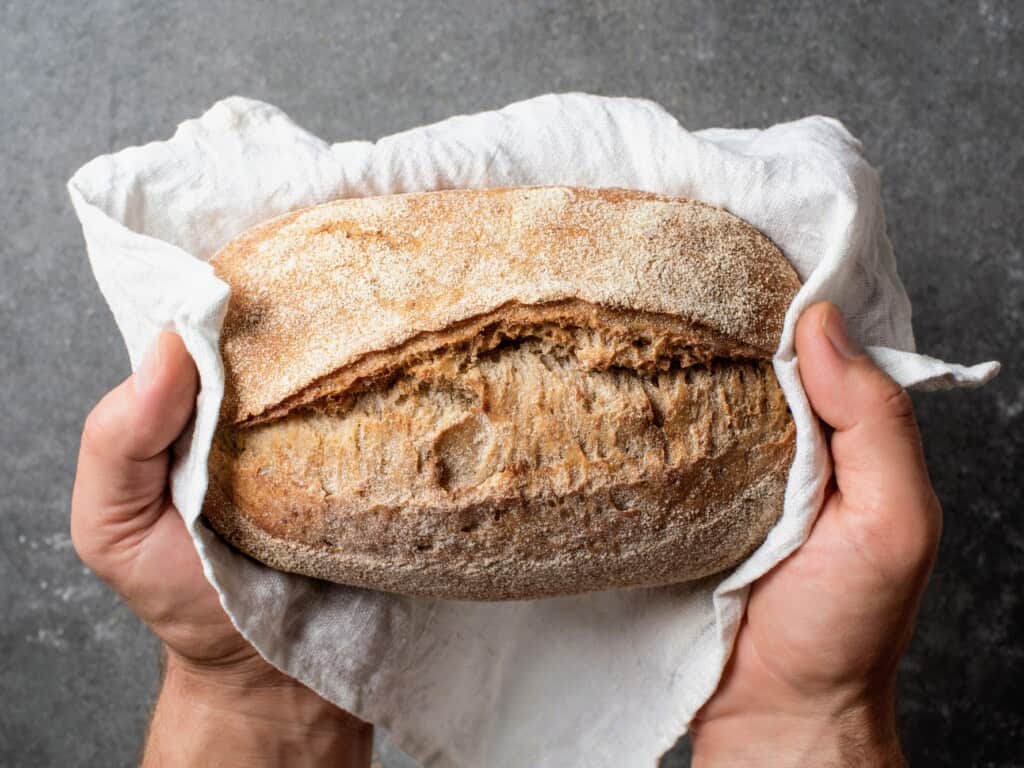
Originally from Veneto, this iconic bread is now internationally beloved. This relatively recent invention was to combat the rising fame of the neighboring french baguette. Afraid that it would take over Italy, Italians developed a larger version similar to a french baguette in flavor but with less crust in proportion to the inside of the bread, full of lots of large air pockets.
Fun Fact: Ciabatta literally translates to “slipper”.
Coppia Ferrarese IGP

Also known as ciopa, ciupeta and pane ferrarese, coppia ferrarese is a double twisted shaped (almost shaped like an X) sourdough bread characterized by the use of lard and malt, dating back to the 13th century from Ferrara (Emilia-Romagna)
Good To Know: The inside of Coppia Ferrarese keeps better and longer than the outside ends so start with the ends and work your way inwards. This way, leftovers keep better!
Grissini

Grissini are hard, thin Italian breadsticks from Turin (Piedmont), often flavored with rosemary, sesame seeds or parmesan cheese. In Piedmont, you will see them served alongside regular sliced bread at the table but in other parts of Italy they have become more of an aperitivo item, served with cocktails.
Grissini date back to the 17th century when Duke Vittorio Amedeo II of Savoy (the important royal family of Turin) suffered from poor indigestion. These crisp crackers were developed in hopes of easing his tummy troubles. It worked and so was born the regional love for grissini!
Panettone

Panettone is a Christmas sweet bread from Milan (Lombardy), made during the holidays throughout Italy. Although most would consider this more of a dessert or treat rather than a bread, it’s anyhow an Italian favorite that I decided to include because of its popularity.
It’s shaped into a wide cylinder and dotted with raisins and candied fruit, although now you can find it made many ways including with chocolate, pistachio and without candied fruit.
Panettone is a very labor intensive bread to make, involving several rises and a sourdough starter. Most Italians don’t make this at home but rather, order them at bakeries or purchase them at grocery stores.
We Recommend: Commercially produced panettoni are easy to get your hands on but they don’t compare to artisan made varieties. I highly recommend going to a forno or bakery and spending the extra bit of money for a really good one. It’s worth it!
Pandoro
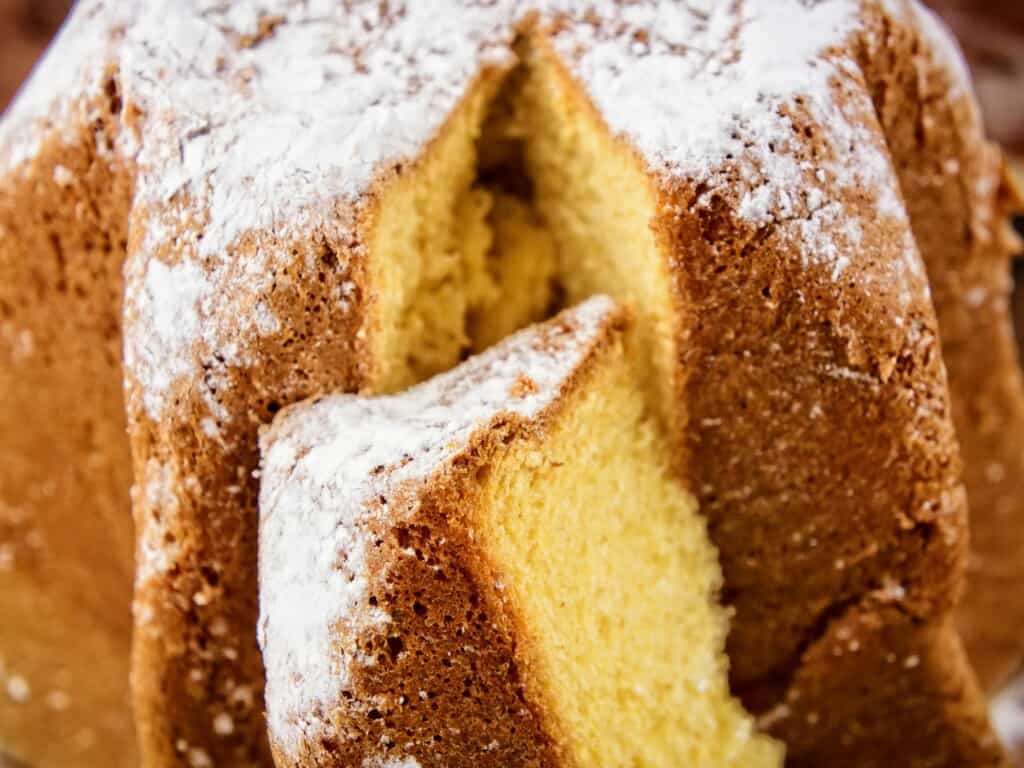
Like panettone, the pandoro is not the typical Italian bread but rather, a sweet yeasted bread from Verona (Veneto). It’s so popular (and tasty) that I had to include it!
This simple, rich dough is shaped into a star mold and baked until golden brown. It’s sprinkled with a heavy dusting of powdered sugar before being sliced for the Christmas holidays.
Fun Fact: Pan means bread and d’oro means golden, meaning golden bread, referring to the rich, yellow color of the dough from all the egg yolks!
Learn More: Pandoro vs. Panettone – An Italian Christmas Cake Showdown and How to Cut Pandoro.
More Italian Bread Types

- Spiga di pane: A long braid-like bread, similar to a baguette: crunchy on the outside and soft on the inside (Abruzzo)
- Baba Rustico: This savory bread, seemingly a sweet cake, is actually filled with various cheeses and cured meats, most commonly served at parties and for special occasions (Campania)
- Pane con Gerda: This is a soft, light bread flavored with bits of cured pork ride for a salt bite! (Sardinia)
- Pane Altopascio: another bread made without salt most commonly served with cured meats and cheeses (Tuscany)
- Moddizzosu: A round, yeasted bread often flavored with pork fat and potatoes, this bread is made in large loaves, lasting for up to ten days! (Sardinia)
- Runditt: A buckwheat flatbread rolled thin, cooked quickly and eaten with melted butter and salt hot off the griddle (Piedmont)
- Torta al testo: also known as crescia, this is a simple flatbread traditionally made without any yeast or leavening agents, often filled with cured meats and cheeses (Umbria)
- Schiacciata: Tuscany’s version of focaccia made extra crispy with plenty of oil and finished with more salt.
- Pane di farro: a darker bread made from spelt flour (Marche)
- Michetta: a bulbous, round bread with a hard crust and almost hollow interior (Lombardy)
- Pane Rustico: a rustic sourdough typical of Sicily, perfectly crusty on the outside and tender and light on the inside, ideal for tasting olive oils.
- Friselle: hard, bagel shaped bread that needs to be rehydrated before being rubbed with garlic, drizzled with olive oil and topped with tomatoes (Puglia)
- Tigella: small, round flatbread baked in clay molds and stamped with a decorative symbol (Emilia-Romagna)
- Pane di Laterza: a round sourdough with a crisp, dark crust and baked in a wood-fired brick oven, resulting in a very aromatic bread (Puglia)
- Civraxiu: a round, crispy bread with a light, yellow interior made from white and semolina flour, water, salt, and yeast (Sardinia)
- Pane di Segale: a soft and fluffy rye bread with a thin crust made with rye flour found throughout Italy but especially up north.

Learn More: You may want to read Is There Garlic Bread in Italy?
Gluten Free Bread in Italy

Artisan gluten free bread is pretty hard to find in Italy. Most of the gluten free bread is sold pre-packaged in supermarkets.
Tip: Ask if there is a specific gluten-free section of the grocery store where you will find all the products in one spot!
Bread in Italy FAQ
Pane ai 5 cereali is a part whole wheat bread made with 5 different grains including oat flour, flaxseed flour, soy flour, rye flour and germ wheat. It’s a light brown color and often finished with mixed seeds on top.
Schiacciata is a type of focaccia and is the term that Tuscans use to call focaccia. What characterizes it differently from focaccia is its outer, crispy crust. Focaccia is soft and fluffy on the outside and inside. Schiacciata, on the other hand, has a very oily, salty crispy crust with a soft, fluffy interior filled with air pockets.
Whole wheat and rye breads are most common in northern Italy where it was once governed by Germans and Austrians. To this day, many of their culinary traditions have been integrated into northern regional cuisine.
Italians will use a crust of bread to clean up their plate after finishing their pasta. They will never eat bread side by side with their actual pasta meal. It’s primarily reserved for appetizers or second course meals.
Italians do not eat pieces of bread with their first course. They will use a corner of bread to mop up any sauce left on the plate but bread is really meant to be eaten with non-carb items such as appetizers and meats.


